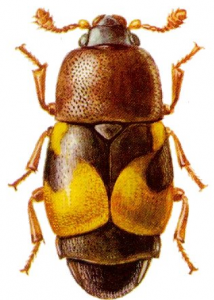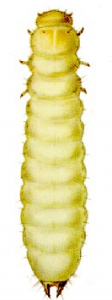 Dried fruit beetles are easy to spot for a couple of reasons; #1 is the tip of each wing has an amber colored spot on the tip and #2 is when they are found in food packaging you’ll see dead ones, molted skins and loads of fecal matter. Yummy! This beetle also will introduce yeast into drying fruit which will cause it to sour. Years ago in my hitch hiking days my sister gave me a bag of dried bananas for my excursion and they were the worst tasting sour things I’d ever had. I gagged so bad trying to eat one of those things, I’m sure I missed a ride or 2 retching on the side of the road. Could I have tasted the infected fruit? I shudder even now some 30 years later.
Dried fruit beetles are easy to spot for a couple of reasons; #1 is the tip of each wing has an amber colored spot on the tip and #2 is when they are found in food packaging you’ll see dead ones, molted skins and loads of fecal matter. Yummy! This beetle also will introduce yeast into drying fruit which will cause it to sour. Years ago in my hitch hiking days my sister gave me a bag of dried bananas for my excursion and they were the worst tasting sour things I’d ever had. I gagged so bad trying to eat one of those things, I’m sure I missed a ride or 2 retching on the side of the road. Could I have tasted the infected fruit? I shudder even now some 30 years later.
Although this is not the most common pantry pest, probably because not a lot of people have dried  fruit in their cabinets, they can still be quite bothersome. The female will lay up to 1000 eggs in her lifetime on ripening or or fermenting fruit sometimes while still on the tree. Eggs hatch in 1 to 7 days and the larvae develop in the fruit from 6 to 14 days. From there they will pupate up to 11 days but the entire life cycle may take several months depending on the temperature.
fruit in their cabinets, they can still be quite bothersome. The female will lay up to 1000 eggs in her lifetime on ripening or or fermenting fruit sometimes while still on the tree. Eggs hatch in 1 to 7 days and the larvae develop in the fruit from 6 to 14 days. From there they will pupate up to 11 days but the entire life cycle may take several months depending on the temperature.
Dried fruit beetles are common in figs, plums, apricots, peaches, nuts, bread, biscuits, grain and dare I say it, bananas. They are small about 1/8 of an inch long and dull to shiny black. Their antenna and legs are light red or brown and they have the distinguishing spot mentioned above. Larvae are about a 1/4 inch long, amber brown in color, covered with spine like hairs and have 2 relatively large projections from the hind end.
 To control these occasional insects it’s best to just remove the infested foods like you would for any other pantry pest. You rarely need to spray but if you do just use pyrethrins for the remaining adults and call it a day.
To control these occasional insects it’s best to just remove the infested foods like you would for any other pantry pest. You rarely need to spray but if you do just use pyrethrins for the remaining adults and call it a day.
Well if this tip doesn’t provide you with any pertinent pest control information that’s Ok, at least you’ve learned never to go hitch hiking with dried bananas as a snack.




